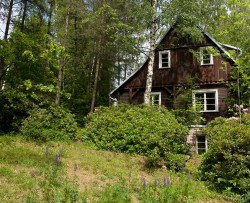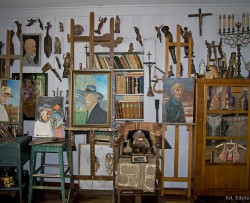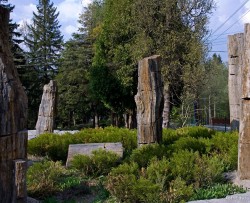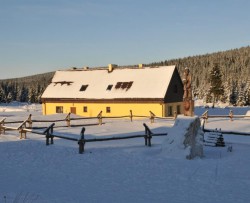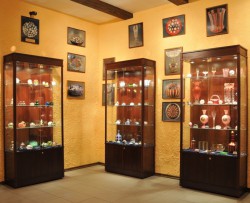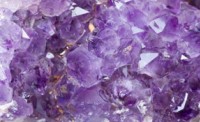- Details
Klimat i wyjątkowy mikroklimat Szklarskiej Poręby doceniono już w latach trzydziesty XX wieku. Wówczas w naszym mieście zaczęły powstawać pierwsze domy uzdrowiskowe i liczne szpitale, w tym chorób płuc.
Wyjątkowość Szklarskiej Poręby związana jest z wysokością i klimatem oraz ukształtowaniem terenu.
Na wysokości około już od 1000 m n.p.m. panują warunki zbliżone do tych, jakie są na 2000 m w Alpach. Odkryli to sportowcy. Polscy kadrowicze często bywają w naszym mieście na obozach kondycyjnych.
Częste wiatry oraz ukształtowanie terenu doprowadzają do bardzo częstej wymiany mas powietrza. Specyficzny mikroklimat tworzą torfowiska oraz śladowe ilości radonu, który przedłuża młodość i dostarcza sił witalnych.
Te naturalne walory są na nowo odkrywane. W mieście powstają kolejne obiekty, których można podreperować swoje zdrowie, kondycję i urodę.
- Details
Po całodniowych wycieczkach, jeździe na nartach, rowerze, nasi goście mogą odwiedzić kilka bardzo interesujących miejsc. W Muzeum Minerałów i Skamieniałości prezentowane są skarby ziemi. Muzeum Karkonoskie prezentuje historię Szklarskiej Poręby. W Starej Chacie Walońskiej snute są opowieści o skarbach Karkonoszy, w Leśnej Hucie można poznać tajniki wytopu szkła, a w ośrodku Parku Narodowego jest multimedialna prezentacja o przyrodzie i historii turystyki w Karkonoszach.
Szklarska Poręba to miejsce, gdzie odbywają się liczne imprezy kulturalne i sportowe uatrakcyjniające pobyt naszych gości. Do największych należy zaliczyć Bieg Piastów, Śniegolepy, Zlot Motocykli Ciężkich i Zabytkowych, Zawody Psich Zaprzęgów, Weekend z Adrenaliną, Akademickie Mistrzostwa Polski w Kajakarstwie Górskim, Ogólnopolska Turystyczna Giełda Piosenki Studenckiej, Festiwal Rowerowy Bike Action, UpHill Sprint MTB, Slalom Gwiazd, Puchar Trójki w Narciarstwie Alpejskim, Turniej Czterech Stoków, Bieg Izerski i Bieg Retro oraz Międzynarodowy Festiwal Kapel Ludowych..
- Details
- Położenie geograficzne i dostępność komunikacyjna. Do Szklarskiej Poręby można dojechać międzynarodową drogą E65 oraz linią kolejową. Bliskość takich miasta jak Wrocław, Praga, Drezno, Berlin.
- Walory przyrodnicze i krajobrazowe dwóch pasm górskich (Karkonosze i Góry Izerskie)
- Walory turystyczne
- Walory sportowe i rekreacyjne
- Klimat
- Ulgi dla inwestorów
- Rozwinięta infrastruktura techniczna, rozbudowana sieć kanalizacyjna i wodociągowa
- Szkolnictwo wyższe i techniczne związane z branżą turystyczną (Jelenia Góra)
- Mieszkańcy
- Details
Turystyka jest najważniejszym działem gospodarki Szklarskiej Poręby. W mieście nie ma przemysłu ciężkiego lub chemicznego i co najważniejsze nie jest on pożądany. W gminie preferowane są obecnie inwestycje w usługi podnoszące poziom konkurencyjności turystycznej i jakości życia mieszkańców.
Szklarska Poręba może przyjąć jednorazowo około 10 tysięcy gości w blisko 300 obiektach, w tym 12 hotelach, kilkunastu pensjonatach, 4 schroniskach oraz 216 w innych obiektach. Szacuje się, że rocznie miasto odwiedza około miliona turystów. W Szklarskiej Porębie jest kilkanaście restauracji, drugie tyle barów, dwie dyskoteki, trzy dancingi, liczne sklepy różnej branży.
Ruch turystyczny obsługuje 4 biura turystyczne oraz Informacja Turystyczna. Odnowę biologiczną oferuje 7 obiektów oraz 2 mikroklimatyczne groty solno–jodowe i 5 małych krytych basenów. W Szklarskiej Porębie jest położony najwyżej w Polsce stadion lekkoatletyczny z bieżnią tartanową, na którym trenuje kadra narodowa, boisko do siatkówki plażowej, kort tenisowy, 3 kręgielnie, osada jazdy konnej oraz rozbudowana sieć wyciągów narciarskich.
W mieście jest 6 muzeów, 3 galerie, 2 dyskoteki, 3 dancingi, 3 kawiarenek internetowych, kilkadziesiąt punktów z bezprzewodowym dostępem do internetu (free hot spot), liczne wypożyczalnie rowerów i sprzętu zimowego oraz kilka szkółek narciarskich.
Podmioty działające na terenie miasta najczęściej zatrudniają do 9 osób. W większości w gastronomi, hotelach, handlu i usługach.
Największymi zakładami pracy są:
- Interferie Sp. z o.o.
- Sudety Lift Sp. z o.o.
- Samodzielny Publiczny Zakład Opieki Zdrowotnej
- Izerskie Centrum Pulmonologii i Chemioterapii NZOZ w Szklarskiej Porębie;
- Nadleśnictwo Szklarska Poręba
- Miejski Zakład Gospodarki Lokalowej
Największym zagranicznym inwestorem działającym na terenie miasta jest ARLBERGER BERGBAHNEN AG z siedzibą w Insbruku, która to zainwestowała w instalację narciarską na Szrenicy.
- Details
Zimowe inwestycje
Nasze miasto jest dynamicznie rozwijającym się ośrodkiem sportów zimowych. Wkrótce rozbudowana zostanie SkiArena Szrenica . Północne stoki oraz nowy system dośnieżania, a także najwyżej w Karkonoszach położone nartostrady, pozwolą na uprawianie narciarstwa zjazdowego od początku grudnia, aż po koniec kwietnia. Będzie to jedyne takie miejsce w polskiej części Sudetów. Rozbudowany system wyciągów, poszerzenia i przebudowa nartostrad, zwiększą komfort i bezpieczeństwo narciarzy.
Szklarska Poręba posiada najlepsze w Europie Środkowej trasy narciarstwa biegowego i śladowego. Planujemy dalszy rozwój ośrodka w Jakuszycach o budowę kolejnych tras, bliżej centrum miasta, przebudowę strzelnicy biatlonowej oraz budowę „zimowego stadionu” w taki sposób, aby móc organizować imprezy rangi Pucharu Świata. Góry Izerskie na terenie których zlokalizowane są trasy biegowe, można śmiało nazwać Polską Alaską.
Plany Inwestycyjne
- Rozbudowa narciarska SkiAreny Szrenica. Jest to inwestycja spółki Sudety Lift. Samorząd, a także lokalny biznes i stowarzyszenia zaangażowały się w tę inwestycję na etapie jej planowania i wydawania zgody na inwestycję na terenie Parku Narodowego.
- Niezależnie prowadzone są prace studyjne nad kolejnym obszarem narciarskim poza Parkiem Narodowym
- Rozbudowa tras biegowych i ośrodka w Jakuszycach. Bardzo ważna jest przebudowa strzelnicy Biatlonowej. Szklarska Poręba już rozpoczęła starania, aby stać się gospodarzem zawodów rangi Pucharu Świata w Narciarstwie Klasycznym.
- Rozbudowa i modernizacja sieci wodociągowo-kanalizacyjnej. Do końca 2009 roku wykonane zostaną inwestycje o łącznej wartości prawie 90 mln złotych. Będzie to rozbudowa sieci kanalizacyjnej i wodociągowej, budowa nowych ujęć wody, stacji uzdatniania, a także nowej oczyszczalni, która zastąpi dotychczasowe trzy małe.
- Esplanada – park miejski w centrum. Chcemy, aby był miejscem spotkań, niewielkich imprez plenerowych, codziennych zabaw, a także prezentacji twórczości wielu artystów mieszkających w Szklarskiej Porębie.
- Remonty drogowe w mieście. Priorytetowym zadaniem komunikacyjnym jest budowa obwodnicy Szklarskiej Poręby. Jest to zadanie Generalnej Dyrekcji Dróg Krajowych i Autostrad.
Ulgi dla inwestorów
Inwestorów traktujemy poważnie. Chcemy grać z Wami „Fair Play”. Dlatego od razu stawiamy sprawy jasno: nie chcemy kopalin, nie mamy miejsca na apartamentowce, nie zgodzimy się na przemysł ciężki i chemiczny oraz uciążliwy dla otoczenia.
Oczekujemy inwestycji turystycznych i podnoszących poziom usług oraz życia mieszkańców. Dla inwestorów cały czas w zależności od potrzeb miasta przygotowujemy ulgi w podatkach i opłatach miejscowych.
Zwolnienia się od podatku od nieruchomości na nowo wybudowane (wyciąg z uchwały rady miasta Nr XXX/339/05)
- budowle i budynki jako całość techniczno-użytkową wraz z instalacjami
i urządzeniami, stanowiące kompleksy rekreacyjno – sportowe, oraz zajęte pod nie grunty, służące do prowadzenia działalności gospodarczej w zakresie rozwoju sportu
i rekreacji, pod warunkiem wykorzystania ich do tej działalności, w szczególności:
- koleje gondolowe i krzesełkowe,
- wyciągi narciarskie orczykowe z podporami,
- instalacje sztucznego naśnieżania,
- nartostrady, tory do uprawiania sportów letnich i zimowych,
- skocznie narciarskie,
- budynki stanowiące zaplecze techniczne obsługi obiektów rekreacyjno-sportowych,
- hale widowiskowo – sportowe,
- schroniska górskie,
- baseny kryte i otwarte z podgrzewaną wodą,
- korty tenisowe
- boiska piłkarskie.
- parkingi ogólnodostępne z liczbą miejsc powyżej 50.
Ponadto istnieje możliwość udzielania ulg w formie umarzania, odraczania i rozkładania na raty wierzytelności Miasta Szklarska Poręba, do których nie stosuje się przepisów ustawy Ordynacja podatkowa według zasad opisanych w Uchwale Nr XLIX/538/06 Rady Miejskiej w Szklarskiej Porębie z dnia 30 czerwca 2006 r.
Oferta inwestycyjna
Aktualne informacje o ofercie inwestycyjnej podawane są na bieżąco na stronie internetowej miasta www.szklarskaporeba.pl
Preferowane inwestycje
- Hotele z rozbudowaną częścią rekreacyjną
- Kompleksy rekreacyjno – sportowe, w tym między innymi rynna zjazdowa, kompleks boisk
- Usługi proturystyczne
- Details
- Details
Polska jest największym beneficjentem pomocy unijnej. W latach 2014-2020 Unia Europejska przeznaczyła dla naszego kraju 82,5 mld €. Podział środków i kierunki ich wykorzystania był przedmiotem dyskusji i uzgodnień władz centralnych i samorządowych z różnymi partnerami.
Fundusze zostaną zainwestowane w zwiększenie konkurencyjności polskiej gospodarki, poprawę spójności społecznej i terytorialnej kraju, w podnoszenie sprawności i efektywności administracji. Najważniejszym celem programów unijnych jest poprawa poziomu życia mieszkańców dzięki wzrostowi gospodarczemu i wzrostowi zatrudnienia.
Na co przeznaczone będą fundusze?
Największe kwoty Polska zainwestuje w infrastrukturę transportową (drogową i kolejową), ale największy wzrost wydatków nastąpi w sferze innowacyjności i wsparcia przedsiębiorców. Nadal finansować będziemy inwestycje w ochronę środowiska i energetykę, a także projekty z dziedziny kultury, edukacji, zatrudnienia czy przeciwdziałania wykluczeniu społecznemu.
Miasta wojewódzkie wraz z okalającymi je gminami otrzymają duże wsparcie na realizację wspólnych przedsięwzięć w zakresie dostępności komunikacyjnej. Ponadto fundusze sfinansują inwestycje w miastach, zwłaszcza projekty związane z kompleksową rewitalizacją, ekologicznym transportem miejskim, gospodarką niskoemisyjną. Wymogiem UE jest również rozwój tzw. inteligentnych specjalizacji, czyli skupienie się poszczególnych regionów na wybranych priorytetach polityki innowacyjnej.
Obok bezzwrotnych dotacji Unia Europejska udostępnia także tzw. instrumenty zwrotne, czyli pożyczki i kredyty. Korzystać z nich mogą zarówno przedsiębiorcy, jak i samorządy.
Perspektywa na lata 2014-2020 będzie wdrażana w Polsce poprzez 6 krajowych programów operacyjnych zarządzanych przez Ministerstwo Rozwoju oraz 16 programów regionalnych zarządzanych przez Urzędy Marszałkowskie.
Programy: krajowe, regionalne i ramowe Unii Europejskiej na stronie Fundusze Europejskie w Polsce oficjalnego serwisu funduszy europejskich.
- Details
Zespół Szkół Ogólnokształcących i Mistrzostwa Sportowego
ul.Obrońców Pokoju 17
tel. 757 172 206
zso-szklarska.pl
e-poczta: This email address is being protected from spambots. You need JavaScript enabled to view it.
Liceum Ogólnokształcące z Oddziałami Mistrzostwa Sportowego
ul. 11 Listopada 2
tel. 757 172 206
LiceumSzklarska.szkolnastrona.pl
e-poczta: This email address is being protected from spambots. You need JavaScript enabled to view it.
Szkoła Podstawowa nr 5 z Oddziałami Mistrzostwa Sportowego im. Wlastimila Hofmana
ul. 11 Listopada 2
tel. 757 172 932, 757 172 932
SzkolaHofman.szkolnastrona.pl
e-poczta: This email address is being protected from spambots. You need JavaScript enabled to view it.
Szkoła Podstawowa nr 1 im. Tadeusza Kościuszki
ul.1-go Maja 32
tel. 757 172 388
SP1Szklarska.superszkolna.pl
e-poczta: This email address is being protected from spambots. You need JavaScript enabled to view it.
Przedszkole Samorządowe nr 2
Osiedle Huty 1
tel. 757 172 716, 757 172 716
Przedszkole2.szklarskaporeba.pl
This email address is being protected from spambots. You need JavaScript enabled to view it.
Samorządowy integracyjny żłobek MAGICZNY ŚWIAT MALUCHÓW
Osiedle Huty 1
tel. 757 677 460
e-poczta: This email address is being protected from spambots. You need JavaScript enabled to view it.
- Details
Karkonosze
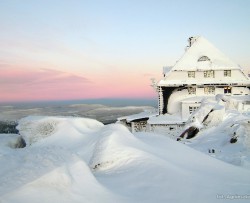
Szrenica Hostel
58-580
Szklarska Poreba, PO Box. 166
Tel.
75 75 260 1911
This email address is being protected from spambots. You need JavaScript enabled to view it.
www.szrenica.pl



The
hostel is situated at an altitude of 1362 meters above sea level, on
top of the hill with the same name, in the Karkonosze National Park,
next to the main tourist trail in Karkonosze (red), 300 m from the
border (15 'to the tourist border crossing with the Czech Republic).
The shelter was built in 1921-22, rebuilt once after a fire on the
roof in 1972.
Access:
chairlift from Szklarska Poreba, on foot - the red trail near the
Kamienczyk waterfall.
90 beds, a private hostel.

Kochanówka Hoste - Szklarki Falls
58-573
Piechowice
Tel:
+48 781 024 159
www.kochanowka.wszklarskiej.net
The hostel is located in an enclave of the Karkonosze National Park, next to the Szklarki waterfall, just 300 meters away from the parking lot by the road E65/national 3. It was constructed in the years 1892-97. Name of the hostel, 'Kochanówka' is linked with the name of Daniel Kochan, a guide in the Sudetes, who was briefly the first head of the property after the acquisition of the hostel by PTTK in 1951. In 2000, the old section of the trail from the parking lot to the waterfall was adapted for disabled visitors.
12 beds, PTTK shelter.

Pod Łabskim Szczytem (Under the Łaba Peak) Hostel
58-580
Szklarska Poreba, PO Box. 167
Tel:
75 75 260 88
This email address is being protected from spambots. You need JavaScript enabled to view it.
www.labskiszczyt.pl

The hostel is situated at an altitude of 1168 m above sea-level, near Łabski Peak on the edge of the Łabski Cirque, in the Karkonosze National Park. Access: from Upper Szklarska Poreba take the yellow trail and go about 2 hours.
50 beds, PTTK hostel.
-
Hostel at Szrenicka Alp
58-580 Szklarska Poreba, PO Box. 164
Tel: 75 717 24 21
This email address is being protected from spambots. You need JavaScript enabled to view it.
www.hala-szrenicka.comThe hostel is situated at an altitude of 1200 m above sea level in the Karkonosze National Park in the west of the Karkonosze, between the two peaks of Szrenica and Kamiennik. Access: from Szklarska Poreba red trail about 2 hours. Established in the late 18th century as a shepherds' shed, it was transformed over time into a youth hostel, and rebuilton a number of occasions, including the fire in 1975.
110 beds, PTTK shelter.
-
Kamieńczyk Hostel
58-580 Szklarska Poreba, PO Box. 47
Tel: 75 75 260 1985
www.schroniskokamienczyk.plThe hostel is situated next to the Kamienczyk waterfall and the main route to Szrenica.
Put in place of a pre-war hostel, which burned down in 1984, it is the first private mountain chalet, built by Janina and Jerzy Sielecki in 1997.19 beds, a private hostel; next to the shelter there is a wooden hut with a hearth inside.
-
Na Chojniku Hostel
58-570 Jelenia Gora - Sobieszów
Tel: 75 755 35 35The hostel located atop the granite Chojnik hill, covered with forest, in the picturesque ruins of a Gothic castle, at an altitude of 627 m above sea level. Walk to the nearest bus stop in Sobieszów approximately 1 hour. The hill is an enclave of the Karkonosze National Park.
-
Revival Hostel
1 Karkonoska St.
58-563 Przesieka, Podgórzyn county
Tel: 75 752 25 46
This email address is being protected from spambots. You need JavaScript enabled to view it.
www.schroniskoodrodzenie.comThe hostel is situated at an altitude of 1236 m above sea-level on the slopes of the Mały Szyszak over the Karkonosze Pass, inside the Karkonosze National Park. Access: from the bus stop in Przesieka via the blue trail 2h.

Holiday Solitude
16 Na
Śnieżkę St.
58-550
Karpacz
Tel:
75 761 93
76
This email address is being protected from spambots. You need JavaScript enabled to view it.
www.samotnia.com.pl
The hostel is located in the Little Pond Cirque, by the Little Pond (Mały Staw), at an altitude of 1195 meters above sea level (12 m above the water), in the Karkonosze National Park. Access: from Karpacz yellow and blue trails approximately 1 hour 30 min. One of the oldest resorts in Poland, the first mention of the shepherd's hut located at the place of today's youth hostel dates back to the 17th century.
50 beds, PTTK shelter.
-
Academic Thatch Hostel
58-550 Karpacz
Tel: 75 753 52 75
Mobile: 601 57 22 20
www.strzecha-akademicka.com.plThe hostel is situated in the middle of Złotówka, a broad, forestless ridge separating the cirque of the Little Pond from the White Canyon at an altitude of 1,258 m above sea level, in the Karkonosze National Park. Access: from the White Canyon 1h or yellow trail from the Wang church in Upper Karpacz blue trail 1h 20 min. The present hotel building was completed in 1907. Used to this day the name "Academic Thatch" came up in the early years after World War II, when the building was owned by university students in Krakow.
140 beds, PTTK shelter.
-
Mouflon Hostel - Over the Okraj Pass
58-506 Kowary
Tel: 75 761 51 10
Jizera Mountains
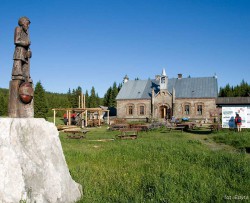
Tourist Station Orle
58-580
Szklarska Poreba-Jakuszyce, PO Box. 140
Tel:
(00420) 607 920
541
This email address is being protected from spambots. You need JavaScript enabled to view it.
www.orle.vulcan.pl
The hostel is located in the Jizera Mountains. It is a remnant of the old glass smelting settlement. The only historic building remaining from the settlement's heyday holds a buffet and the fireplace room. This building of hewn stone, also called "the Forester's", now part of the tourist base "Orle", has been built around 1860, probably as the glassworks administration building. Accommodation is located in the former WOP guardhouses, two buildings built in the 1930's. Access: from the base of "Piast Race" in Jakuszyce - asphalt road, about 5 kilometers to the hostel. A little shorter route is the red trail leading from Jakuszycka Glade through the "Airplane" lookout point, also straight to the hostel.
40 beds.
-
Mountaineers Shack Hostel
Świeradów Zdroj 59-850, PO Box. 31
Tel: 75 75 32 533
mobile 607 426 998
This email address is being protected from spambots. You need JavaScript enabled to view it.
www.chatkagorzystow.prv.plThe hostel is located in the Izerska Alp. It is the only building (former school) left of the village of Gross-Iser, existing here since 1630. Access: Jakuszyce red trail from the "Orle" Hostel and on to the Mountaineers' Shack, yellow trail from the Jisera Crossroads through the Pod Kopą Crossroads, the blue trail from Świeradów Zdrój through the Jizera Glade to the hut.
40 beds.
-
Na Stogu Izerskim Hostel
59-850 Świeradów Zdrój, ul. Coast 1
Tel: 75 75 22 110
This email address is being protected from spambots. You need JavaScript enabled to view it.
www.stogizerski.prv.plThe hostel is situated at an altitude of 1,061 m above sea-level in the western part of the High Ridge. It was established in 1924 at the initiative of the Society of the Karkonosze. Access: from Świeradów Zdrój about 2 hours or 10 minutes by the gondola lift.
47 beds, PTTK shelter.
(*) All information based on the content of respective web pages on the objects as well as from www.pttk.pl
- Details
Tourist trails in Karkonosze and the Jizera Mountains
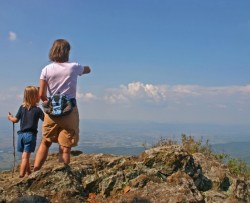
Hiking in the mountains has a rich, centuries-old history in our mountains.
The region of Western Sudetes has a very well-developed tourist infrastructure. The network of hiking trails, leading from the one attraction to another, from hostel to hostel, creates a very friendly atmosphere for mountain hiking and not just for expert hikers.
The major trail in the Sudetes goes through the Jizera and Karkonosze; this is the GSS trail of Mieczysław Orłowicz, marked in red, which starts in Świeradów Zdrój and after passing the whole of Sudety mountains (about 350 km) ends in Paczków. Other trails marked in green, yellow, blue, and black are connecting, circulating, or other versions of GSS.
Moreover, Szklarska Poreba is also the place of thematic tourist trails. During the hiking tour via the chosen path, you can read about the history, culture, tradition and ancient beliefs and customs of the inhabitants of the Jizera Mts.

Enjoy wandering around Szklarska Poreba and explore some of our biggest attractions. Visit the kingdom of Karkonosz, o the Magical Trail of the Mountain Spirit, find the most valuable treasures at the Walloon Trail and spend a nice time wandering with trifles via the Big Sztaudynger Tourist Trail.
However, all nature lovers would enjoy the natural walking paths of the Karkonosz National Park. more ...
More photos in the author's gallery Sigmund Trylański.
![]() see film
see film
- Details
Bike rentals

STACJA JAKUSZYCE
Szklarska Poręba - Jakuszycka Glade
Phone: +48 668 667 088, www.stacja-jakuszyce.pl
E-MAIL: This email address is being protected from spambots. You need JavaScript enabled to view it.
Invites those who have not yet decided to purchase their own equipment, did not take their two-wheeled friends from home, or do not believe in their own strength or that mountain biking is too hard for them. We offer you new, very good equipment - Scott brand mountain bikes in various sizes, also for the youngest. You can reach us by car or train, and we offer you the beginning of a trip to the most popular locations, Jizera hostels of Orle or Mountaineers' Hut. The bike will be your faithful friend with the proper motivation. Find it hard to believe? Visit us at the Jakuszyce Station.

Rowery Izery
Ośrodek Biathlon - Jakuszyce 7
Pałac Wojanów - Wojanów 9
tel: 667751994
tel: 663981750
tel: 534708129
http://www.roweryizery.pl
www.facebook.com/roweryizery

Wypożyczalnia rowerów, przyczepek, fotelików i nosidełek PaulosportXXL.
ul. 1-go Maja 20c/1
58-580 Szklarska Poręba
Tel: 75 616 24 65
email This email address is being protected from spambots. You need JavaScript enabled to view it.
Czynne
pon-śr. 10:00 - 18:0
czw. - sob. 10:00-20:00
niedziela 10:00 - 18:00
www.paulosportxxl.pl
 Wypożyczalni rowerów elektrycznych Ride Guard Sp. z o.o.
Wypożyczalni rowerów elektrycznych Ride Guard Sp. z o.o.
Hotel Interferie Sport, ul. Mickiewicza 21, Szklarska Poręba
Czynne codziennie od 9:00-18:00.
W ofercie rowery z wspomaganiem elektrycznym marki KTM - eLycan, eCross, eRace, eFun.
Dodatkowo organizowane są wyjazdy na Singltrek pod Smrkem.![]() Cennik [Adobe Acrobat PDF - 358.38 KB]
Cennik [Adobe Acrobat PDF - 358.38 KB]
tel. +48 790 327 327, 512 145 629, 786 188 888
This email address is being protected from spambots. You need JavaScript enabled to view it.
 Wypożyczalnia rowerów "SZKLARSKA BISTRO"
Wypożyczalnia rowerów "SZKLARSKA BISTRO"
dworzec PKP
Szklarska Poręba Górna
+48 571 348 418
www.szklarkabistro.pl
This email address is being protected from spambots. You need JavaScript enabled to view it.
W cenę wypożyczenia wlicza się rower, przechowania bagażu, kask, mapa rowerowa i espresso na doładowanie przed trasą :)
Rower można zarezerwować dzwoniąc pod numer: 571 348 418
- Details
Szklarska Poreba on two wheels.
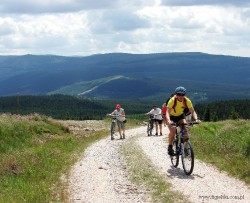
Anyone who tasted mountain biking doesn't need convincing about the strengths of this form of active recreation. Traversing mountain trails on two wheels makes it possible to cover longer distance than on foot, brings with it a sense of space and independence, often raises adrenaline level, and provides a lot of positive emotions.
Developing our offer for cyclists systematically, Szklarska Poreba aims to become the "Polish Cycling Capital".
The first complex of 12 cycling routes around Szklarska Poreba with a total length of 278.3 km was put to use in 2001. This was the beginning...
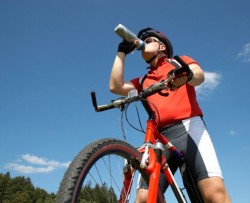
In order to meet the huge demand for this form of active recreation, the trails and coverage length expands on a yearly basis. The cycling routes run along the scenic roads of Karkonosze and the Jizera Mountains, only partially routed on roadways, so that after quickly leaving the city center (trails junction) one can immediately switch to the forest roads - mainly gravel ones. All the trails are looped, which means they can be freely combined with each other, and each of them will eventually lead you to the where you started from. Bridging the mountain trails on two wheels brings great satisfaction and unforgettable experience. We offer both easy routes for novice mountain bikers, as well as very difficult routes, raising the level of adrenaline to the maximum. Particularly beautiful bike paths have been set in the Jizera Mountains. When you drive on the plateau of the Jizera Mountains, while crossing the slope from the Black Mountains or the High Stone, all the time you will be accompanied by a beautiful panorama of the Karkonosze range, parallel to the trail.
Szklarska Poreba is a cyclists-friendly city. We have here the bike rentals, service stations and shops with equipment and bicycle accessories.
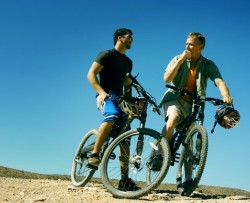
Our town is a great starting point for starting road trips into the Polish and the Czech Jizera Mountains and Karkonosze and an attractive tourist destination on either side of the border. The cycling routes of Szklarska Poreba combine trails surrounding Harrachov (CZ) for tourist-mountain border crossings.
![]() See fim
See fim
More
info at www.rowerowakraina.com.
More
photos in the author's gallery of Zygmunt Trylański.
- Details
Skiing Statement
- open lifts : 5
- open ski pistes : 5
- open slopes : 5
- Cross-Country routes : Polana Jakuszycka
- Snow conditions Sudety Lift
More
about ski conditions
GOPR
– conditions in The mountains
SkiArena
Szrenica – live view
- Details
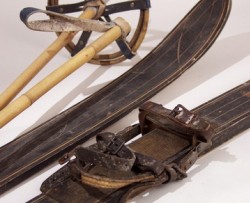
- BETA rentals, Turystyczna St. (next to the supermarket "Net"),
mobile +48 605 602 491
- DAGA-SPORT (near the Training Centre and the Olympic Training in
Biathlon, 7 Jakuszyce, mobile +48 600 681 716
- Sebastian Głodek, rental skis and snowboards, sleds and quads, ski
service 19 Turystyczna St./ corner of Ski
St./ Mobile: +48 504 566 055
- GÓRNA WILD, 2/2 Hutnicza St. / 16 Turystyczna St., tel. +48 75 717 35
63
- Leszek Szymanski, 24a and 28a Turytyczna St., mobile +48 601 581 318
- RAFA - SPORT, 30 Turystyczna St., sport equipment rental, service,
Fisher test center, Tel: +48 75 717 32 89, www.rafa-sport.pl
- RELAX Remigiusz Makowski, 2, 8 Turystyczna St., Mobile +48 692 405 453
- Mariola Rusin, 1 Turystyczna St., mobile +48 668 910 774
- SIC-BOO Krzysztof Wiarkowski, 24 Turystyczna
St., Mobile +48 600 351 635, 11-Listopada
St. (in the Valley of Happiness), Turystyczna
St.(near the Pietkiewiczówka lift)
- SKI Górnicki, Babiniec by the road to Jakuszyce, mobile +48 607 462
038
- SKI TOUR,18a Turystyczna
St., tel. +48 75 717 26 14
- Station-SZRENICA parking by the new lift to Szrenica - rentals and
testing center for SALOMON, ATOMIC downhill skis and snowboards
brand.
Shop
and service. http://stacja-szrenica.pl,
This email address is being protected from spambots. You need JavaScript enabled to view it., mobile +48 795 225 597.
- TECH-SPORT - SERVICE "Jarecki", 5 Gimnazjalna St., Tel: +48 75
717 30 62
- TOP-Ski Rental of ski equipment, 17a and 25b Turystyczna St.,
tel./fax +48 75 717 28 22, mobile +48 505 17 10 14
- VIEW Rental, Valley of Happiness, 13, 11-Listopada
St., Mobile: +48 606 526 325, 25b and 23 Turystyczna St., Mobile +48 606 526
325, 1
Urocza St., Mobile +48 888 721 883
- Rentals 20 Jedności Narodowej St., Mobile +48 788 190 977
- Rentals Turystyczna
St.,
Mobile +48 669 476 888
- Wypożyczalnia i sklep turystyczno-sportowy PaulosportXXL.; ul. 1-go Maja 20c/1; 58-580 Szklarska Poręba; This email address is being protected from spambots. You need JavaScript enabled to view it.; tel. 75 616 24 65; www.paulosportxxl.pl
- Details

Już w najbliższą niedziele w muszli koncertowej Parku Miejskiego Szklarskiej Porębie Poręby zagra legendarna Wolna Grupa Bukowina.
- Details
W tym wielojęzycznym tłumie biegaczy słychać często swojskie „Ahoj”. Doceniając jakość polskich tras coraz więcej naszych czeskich sąsiadów przechodzi na naszą stronę Gór Izerskich. Co ciekawe, trenują na nich również czescy zawodnicy.
- Details
Szklarska Poręba - Jakuszyce - to bez wątpienia jeden z najlepszych ośrodków narciarstwa biegowego w Europie. Potwierdzeniem jest rosnąca z roku na rok na jakuszyckich trasach liczba obcokrajowców i płynące z ich ust słowa zachwytu. Dzięki doskonałym warunkom klimatycznym, pokrywa śnieżna zalega grubą warstwą do późnej wiosny (ostatnia impreza narciarska, Śnieżna Majówka, rozgrywana jest rokrocznie 1-go maja). Od lat na terenie ośrodka rozgrywana jest znana wśród miłośników narciarstwa biegowego, największa tego typu masowa impreza w Polsce – „Bieg Piastów.”
- Details
- Miasto
- Informacje
- Ważne telefony
- Parkingi
- Usługi turystyczne
- Karkonoski Park Narodowy
- Instytucje użyteczności publicznej
- Edukacja
- Służba zdrowia
- Kościoły
- Ubezpieczenia
- Autocentra
- Banki
- Kawiarenki internetowe
- Przejścia graniczne
Miasto
Urząd Miejski w Szklarskiej Porębie
ul. Granitowa 2
tel. 75 7547700
58-580 Szklarska Poręba
- miasto Szklarska Poręba w powiecie jeleniogórskim, w województwie dolnośląskim
- obszar 75 km2
- liczba mieszkańców 6500
- kod pocztowy 58-580
- telefoniczny numer kierunkowy 75
Informacje
- Referat Promocji Miasta, ul. Jedności Narodowej 1a, tel. 75 75 47 740
- Iformacja Turystyczna, ul. Jedności Narodowej 1a, tel. 75 75 47 740
- Informacja Narciarska, tel. 75 717 21 18
- Informacja PKP, tel. 19 747, www.pkp.pl
- Informacja PKS , tel. 703 403 337, www.pks.jgora.pl
- Postój TAXI ul. 1 Maja, tel. 75 717 21 03
- Halo Taxi 24h: 75 717 30 53; 606 404 135
- Euro Radio Taxi Szklarska Poręba - Jelenia Góra, tel. 75 196 25 lub 695 25 25 25 lub 800 123 000 (bezpłatne zamawianie)
Ważne telefony
- Karkonoska Grupa GOPR - tel. alarmowy 985, 601 100 300, Stacja ratunkowa Szklarska Poręba tel. 757 173 393, Karkonoska Grupa GOPR
- Policja - tel. alarmowy 997, Komisariat Policji Szklarska Poręba, ul. Granitowa 1, tel. 757 545 400
- Straż Miejska Jedności Narodowej 32, tel. 757 173 941, 603 376 607
- Straż Pożarna - tel. alarmowy 998, OSP tel. 757 172 288
- Pogotowie Ratunkowe - tel. alarmowy 999,
- Przychodnia Rejonowa SPZOZ ul. Jedności Narodowej 11, tel. 757 172 155
Parkingi
- ul. 11 Listopada
- ul. 11 Listopada
- ul. Turystyczna
- ul. Turystycznej
- ul. Mickiewicza
- ul. Mickiewicza
- ul. Prusa
- ul. Kilińskiego
- ul. Uroczej
- ul. Jeleniogórskiej
Usługi turystyczne
- BT "ALMAR" - ul. Jedności Narodowej 6, tel / fax 75 717 21 23
- BT "KORONA" - ul. Jedności Narodowej 20/ul. 1 Maja 5, tel / fax 75 717 29 99
- BT "WNW" ul. Wzgórze Paderewskiego 4, tel/fax 75 717 21 00
- BP Trendy Travel, ul. Mickiewicza 5, tel. 75 76 77 262,505 172 127
- BT Pinokio Travel - ul. 1 Maja 5, 75 76 90 884, 693 952 660
- Wycieczkowe ABC - ul. Jedności Narodowej 26 tel. +48 660 010 130/131
- Koło Przewodników Sudeckich
Karkonoski Park Narodowy
Siedziba dyrekcji w Jeleniej Górze przy ul. Chałubińskiego 23, tel. 757 553 348
kpnmab.pl
Opłaty za wstęp do Karkonoskiego Parku Narodowego oraz za wstęp do Wąwozu Kamieńczyka.
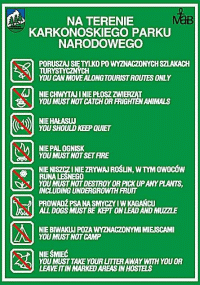
Instytucje użyteczności publicznej
Edukacja
Służba zdrowia
Kościoły
- Parafia Rzymsko-Katolicka p. w. Bożego Ciała, ul. Franciszkańska, tel. 757 172 282, www.szklarska.franciszkanie.pl
Msze Św.: w tygodniu:
godz. 8, 17 (październik-kwiecień), 18 (maj-wrzesień)
w niedzielę i święta: o godz. 7, 10, 1130, 15, 17 (październik-kwiecień), 19 (maj-wrzesień) - Parafia Rzymsko-Katolicka pw. M. Kolbe, ul. Mickiewicza, tel. 757 131 227, www.maksymilian-szklarska.pl
Msze Św. w niedziele:
w kościele przy ul. Mickiewicza 16 - o godz. 730, 9, 1030, 12, 18
w kaplicy na Białej Dolinie przy ul. Wolności 11 - o godz. 930 - Kościół pw. Niepokalanego Serca NMP, ul. Piastowska, www.szklarska.franciszkanie.pl
Msza Św. w niedziele o godz. 1030 - Kościół Zielonoświątkowy w Jeleniej Górze, placówka w Szklarskiej Porębie, Kościół "Na Skale". Nabożeństwa w niedzielę o godzinie 1700 w OSSiR Mauritius (duża sala konferencyjna), ul. Dworcowa 6 , tel. 601 587 273
Ubezpieczenia
- PZU Ubezpieczenia Donat Pawłowski, ul. Jedności Narodowej 9, tel: 517 788 509 , Agent PZU
- Danuta Szulc - agent ubezpieczeniowy, ul. Franciszkańska 36a, tel. 75 7173379, 510 238 500
- BT "ALMAR" - ul. Jedności Narodowej 6, tel. 75 717 21 23
Autocentra
- Centrum motoryzacyjne, ul. Partyzantów 5b tel. 75 717 27 65 tel. kom.
Banki
- Santander, ul. Jedności Narodowej 16 tel. 757 538 190 do 192; bankomaty: przy ul. Jedności Narodowej 16 i przy ul. Małej 1a
- PKO BP, ul. Jedności Narodowej 5 , tel. 757 174 730, bankomat
Kawiarenki Internetowe
- pensjonat "Lider", ul. Cicha 4 tel. 75 717 20 43
Przejścia graniczne
| Przejście graniczne | Jak można przekraczać |
|---|---|
| Szrenica - Szklarska Poręba Twarożnik / Vosecká Bouda |
 |
| Szklarska Poręba - Harrachov drogowe - droga E65 |
|
| Polana Jakuszycka - Szklarska Poręba Szklarska Poręba / Harrachov - Metiny |
|
| Przesieka - (Przełęcz Karkonoska) Podgórzyn Spindlerowy Młyn |
|
| Równia pod Śnieżką - Karpacz Luční Bouda |
|
| Stóg Izerski Smrk |
|
| Czerniawa Zdrój Nove Mesto drogowe - droga nr 361 |
|
| Sowia Przełęcz - Kowary Soví Sedlo |
|
| Przełęcz Okraj - Kowary Pomezni Boudy drogowe - droga nr 368 |
|
| Lubawka Kralovec drogowe - droga nr 5 |
|
| Orle Orle / Jizerka |
|
| Niedamirów-Lubawka Žacléř |
- Details
HOUSE OF WLASTIMIL HOFMAN
23 Matejko St.
Tel: +48 75 717 27 52
Open: visiting the house is only possible when the hosts are home. You can make an appointment by telephone.
Here is a unique opportunity to visit the house of painter Wlastimil Hofman, virtually unchanged since the artist’s death. The interior of this seemingly tiny house holds e.g. the master's studio, with his easels still standing and his brushes and paints still lying on the table. As the current host, Mr. Wacław Jedrzejczak, says, the atmosphere of the place is still filled with the artist’s spirit, which can be experienced in no other museum.
Wlastimil Hofman (1881-1970) - called by Jan Sztaudynger "the painter of the inner glow", recognized in Poland and around the world, the artist - painter, poet, student of Stanisławski, Wyczółkowski and above all, Jacek Malczewski. In 1947, he moved to Krakow to Szklarska Poreba persuaded by Sztaudynger, and lived with his wife in a small house on Średnia St. Hofman grew very familiar with the local community and painted many portraits and small images for the residents, but the main buyers of contemporary art were the local Franciscans. Many of his works have adorned private homes and local churches.
Hofman’s House - Wlastimilówka, soon became a meeting place for the local artistic community. After the death of the painter, following his last will the house with all its equipment was transferred to Mr. Wacław Jedrzęjczak. Current owner provides visitors with access to the painter’s studio, as well as two small rooms with paintings.
HOUSE OF GERHART AND CARL HAUPTMANN next to Karkonosze Museum
23, 11 November St.
Tel: 75 717 26 11
www.domhauptmannow.pl
Opening Hours: Tuesday – Sunday: 9:00 - 16:00
Admission: adults – 6PLN, children – 3PLN
Permanent exhibitions in the House of Carl and Gerhart Hauptmann:
1. In the realm of the Spirit Mountain
2. Products of “Józefina” ("Josephine") glassworks in Szklarska Poreba
3. Gerhart Hauptmann and his social circle
4. Brotherhood of St. Luke (Łukaszowcy)
5. Carl Hauptmann and his friends
6. Wlastimil Hofmann and the early post-war years of the colony
7. Artists of glass and photography
8. The youngest generation of artists in Szklarska Poreba
more SEE HERE
KARKONOSZE ENVIRONMENTAL EDUCATION CENTER
28 Okrzei St. tel 75 717 21 24
Open: Tuesday to Saturday from 09:00 to 15:00.
Everyone interested in sightseeing the natural diversity and richness of the Karkonosze, is invite to visit the Karkonosze Environmental Education Center in KPN.
During the tour, the visitors learn about the world of animate and inanimate nature of the Polish and Czech side of the mountains. Several rooms presented interactive exhibitions of glacial cirques, peatbogs, flora and fauna, forests, natural phenomena and human impact on the mountains. The exhibition is made more attractive due tolarge panoramas, tactile model of the Karkonosze and the languages: Polish, Czech, German and English. Film screenings, diaporamas and various presentations are held in a comfortable screening room. All this is supplemented with temporary exhibitions and a modern library with a reading room. In addition to providing exhibitions in the Karkonosze Environmental Education Center, based on the education employeesm classes are held (inside and outside) for organized school groups, teachers, students and local communities. You can buy books, maps, brochures and other publications promoting the Karkonosze. The object is adapted for the disabled.
Whatever the weather, it is worthwhile to see the "Virtual Karkonosze” multimedia exhibition before moving off to the trail, or after another trip to the mountains.
MINERALOGICAL MUSEUM
20 Kilińskiego St, http://dolnyslask360.pl/miejsce.php?q=253
mobile 607 100 880,
e-mail: This email address is being protected from spambots. You need JavaScript enabled to view it.,
www.sokolowski-muzea.pl
Opening Hours: Tuesday-Saturday 10 - 18:00, Sunday 10 - 16:00, Monday - closed; during the season open daily from 10:00 to 18:00
Admission: adults – 10PLN, pensioners and students – 7PLN (upon presenting a proper document), youth under 18 years – 5PLN, children under 5 – free
The museum operates since 1993, led by the Sokołowski family: Renata, Grzegorz and their son Kazimierz. The parents passion is also shared by two daughters who keep a similar facility in Kamien Pomorski.
The museum in Szklarska Poreba holds about 3,000 exhibits of minerals and fossils from around the world, as well as an exhibit from space – theGibeon meteorite. In front of the museum building, there is a unique in Europe "Carboniferous forest". It consists of fossilized trunks of Dadoxylon trees, which grew about 300 million years ago.
Fossils and dinosaur skeletons are a curiosity found in the museum. It is Poland's largest private collection of reptiles from millions of years ago. Among the specimens, for example, you can see dinosaur eggs from China.
The oldest fossils in the museum are the 570-million-years-old stromatolites from Kaczawskie mountains and the trilobites dating back to the lower Cambrian (530 million years).
The museum also holds the audio-video room, which presents popular science films.
Mineralogical Museum - 360 Panorama
MUSEUM OF THE EARTH – JUNA (closed)
9 Jeleniogórska St.
Tel. +48 75 717 32 87,
e-mail: This email address is being protected from spambots. You need JavaScript enabled to view it.,
www.chatawalonska.pl
Museum closed.
The museum presents a permanent exhibition of decorative and precious stones from the Sudetes and the world of arts and crafts and products. The collection includes many specimens of minerals from Lower Silesia, Poland and the world. You can see, among others several-kilogram blocks of quartz from the Jizera Mountains, some of the largest excavated agates from Nowy Kościół (Lower Silesia), smoky quartz crystals from the Kowarska Pass, solid banded flint from the Holy Cross Mountains as well as charoite nuggets weighing about a kilogram from the Ural, malachite stalactites from Kenya and tens of kilo amethyst geodes from Brazil.
The Museum of the Earth is selling handicraft products of glass, ceramics, wood, gemstones, raw minerals - collectibles and accessories.
GLASSWORKS
Jakuszyce - Orle, Tel: +48 608 688 408, e-mail: This email address is being protected from spambots. You need JavaScript enabled to view it., www.szklanahuta.pl
Open from May 1 to October 31 Opening hours: from 10.00 to 16.00. Closed on Mondays. Visiting possible after prior arrangement.
Admission: Adults: 7PLN, schoolchildren: 5PLN, children under 6 years - accompanied by an adult are free of charge. The ticket price includes a commemorative postcard.
The only in Poland, and one of the few in the world, exposure of glass paperweights and millefiori glass pieces. You can admire these in the Glassworks - a historic grindery building of Carlsthal glassworks, renovated a year ago.
You can see hundreds of exhibits, mostly paperweights made with laminated glass and filigree glass techniques as well as millefiori, the noblest art of glass-making. The word "millefiori" derives from the Italian "mille fiori" and means "a thousand flowers." Historically, millefiori technique comes from ancient Egypt. For centuries, it has been the most closely guarded secret of glass masters who possessed it. Taken with the master to his grave, frequently forgotten for tens and hundreds of years, the technique would then be reborn and die again throughout history. The rebirth of this technique took place in the first half of the nineteenth century the glassworks of Karkonosze and in Venice.
It is no coincidence that the Museum is housed in a restored building of the former grindery of the Carlsthal glassworks, which was where Franz Pohl began producing glass in the filigree and millefiori techniques. The revival of the art took place in the second half of the twentieth century and continues to this day. The can also holds paperweights that are works of contemporary artists from around the world, as well as the work of the only Polish artist who recreated the millefiori technique in our country throughout the last decade.
More about the Glassworks.
- Details
Szklarska Poreba, "the Pearl of Karkonosze"
Szklarska Poreba is a holiday and tourist town at the foot of the Karkonosze and the Jizera Mts. It is located on the shortest route between Prague and Wroclaw, not too far away from Saxony or Berlin. The advantageous location among forests on the banks of the Kamienna River, in an area abounding in rich deposits of quartz, resulted in the ongoing development of the manufacture of glass since the Middle Ages. In 1842, a glass factory, "Josephine" /later "Julia"/ has been opened, which became one of the most famous in the world. Szklarska Poreba has become a popular holiday resort, and was dubbed "Pearl of Karkonosze".
At the end of the 19th century people of science, literature and art began coming to Szklarska Poreba. Attracted by the majesty of the mountains, peace and close contact with nature, they chose to break free from the urban bustle. Numerous such exceptional places - art colony – were created in Europe. The most famous is the French Barbizon, German Worpswede, Zakopane, Kazimierz on the Vistula River and Szklarska Poreba.
In 1890, during one of their trips, Carl and Gerhart Hauptmann, fascinated with the sheer beauty of Karkonosze, decided to settle here. After years, Gerhart Hauptmann recalled this event:
"One day while hiking in the mountains, I saw a valley from up high, and thought it would be good to build a house here. Delighted and dazzled by the idea I came down through the woods, ran a path among the meadows, and within a few hours arranged for the purchase of a farmhouse with some land, with a meadow, with a grove and springs."
In Szklarska Poreba Gerhart Hauptmann has created some of his best naturalistic dramas such as "Die Weber" – ‘The Weavers’ "Der Biberpelz" – ‘The Beaver Fur’, or "Hanneles Himmelfahrt" – ‘The Rapture of Hania”. Since 1901, he settled in nearby Jagniątków. In 1912, Gerhart Hauptmann received the Nobel Prize in literature. His older brother Carl Hauptmann remained in Szklarska Poreba. PhD in philosophy and a writer, who described in his works the beauty of the Karkonosze. His most recognized work is the series of legends about the Mountain Spirit - Liczyrzepa – titled "Rübezahlbuch" – ‘The Book of Liczyrzepa’. Carl Hauptmann also made a literary correction to the translation of a novel by Wladysław Reymont's, titled “Chłopi” (‘The Peasants’) into German.
Other well-known writers also lived in the art colony in Szklarska Poreba at the beginning of the 20th century: William Bölsche, Bruno Wille and Hermann Stehr. The economist and sociologist Werner Sombart also visited quite often. Carl Hauptmann shared ties of friendship with a composer Anna Teichmüller, who lived here. Her musical works were performed in major concert halls of Germany. Today these works are almost completely forgotten.
In 1922, the "Künstlervereinigung St. Lukas in Oberschreiberhau" (“St. Luke Artistic Association in Szklarska Poreba”) was established, consisting of twelve artists who settled in the area and took in the Karkonosze landscape painting in Szklarska Poreba in the early 20th century.
Following the end of World War II, Szklarska Poreba began to regain its holiday resort character. The crystal glass factory has resumed its operation, and new residents included Wlastimil Hofman, a well-known painter, who painted in the spirit of symbolism of the Young Poland.
Artists in Szklarska Poreba – present-day art colony
Szklarska Poreba is still a live art colony, inhabited by people of culture and active painters, photographers, sculptors and others, who draw inspiration from the picturesque landscape of our city.
Artists in Szklarska Poreba

Many
of them are members of the New Mill Association, created in the image
and likeness of the Art Association of St. Luke, operating in
Szklarska Poreba in the twenties and thirties of the 20th
century. Our town is where such artists live and work, as Zbigniew
Frączkiewicz - sculptor, creator of the monumental sculptures of
stone and iron, the author of one of the most important sculptural
series carried out in Poland, titled Ironmen (1984), and Beata
Kornicka-Konecka andJanusz Konecki, a creative couple, whose paintings and prints are
known not only in Poland but all over the world.
Szklarska
Poreba artistic environment focuses professional and amateur artists,
some experienced and mature, many others young, fresh, passionate for
the arts. What's important the works of these artists can be seen not
only in exhibitions in the local museum, but also on the city's
postcards (photographs by Zygmund Trylański), in the city ("Ironmen"
Z. Frączkiewicz, the figure of the "Spirit of the Mountains"
by Grzegorz Pawłowski) and even on the tourists trails (stones
with reliefs by Maciej Wokan, which are elements of the Magic Trail
of the Mountain Spirit).
Szklarska Poreba, together with Kazimierz Dolny, are the only Polish art colonies that are members of the EURO-ART European Federation of Art Colonies. www.euroartcities.eu
More on the artists of the New Mill Association – READ
EKOGLASS Festival
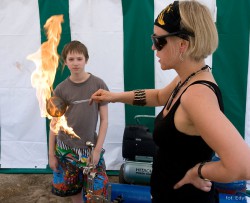
In 2008,the activity of glazier artists was reactivated in Szklarska Poreba, through the implementation of specific open-air events, titled EKOGLASS FESTIVAL. A city with a centuries-old tradition of glass manufacture, which coincided with a colony of artists cannot lack events linking these two professions. Ekoglass Festival is a creative meeting of glassworkers and glaziers, during which wonderful and unique pieces of work are made. In addition, the idea of this art event is taking care of the environment, so all forms of glass created during the festival are made by re-melting cullet. The event takes place at Leśna Huta, led Henry Łubkowskiego, master of Karkonosze glass. Every year, the Festival draws ever greater artistic glass makers, not only Polish, but also from the Czech Republic and Slovakia. The event is open to spectators. During the several days of the festival you can see the work of steelworkers and artists working in different techniques.
Open-air art events
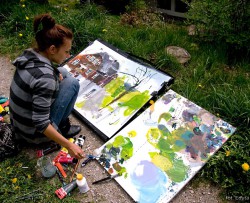
Every year open-air crafts events are also held in Szklarska Poreba for young artists - students of Polish universities. For two weeks in the spring (May/June), students come to us from the Wroclaw Academy of Fine Arts: painters, glaziers, sculptors. Under the guidance of college professors: Dr. Piotr Tyszkowski, Dr. Małgorzata Dajewska andDr. Mariusz Łabiński, young artists take part in activities conducted in the town as well as in Leśna Huta, under extra care ofHenryk Łubkowski.

The weekly open-air classes in photography in Szklarska Poreba attract the students of Wroclaw photography schools PHO BOS. In addition to practical classes lectures are also held, as well as photo exhibitions and meetings with known photographers.
For several years now, a sort of ceramic center is created around the guesthouse “Raad na Uroczysku”, where Polish and international open-air activities are organized, as well as workshops for residents and visitors, titled: "Ceramics and you", along with many other activities to promote this field of creativity.
The effects of work of young artists from Wroclaw Academy of Fine Arts, students of PHO BOS and ceramists from the Cracow Academy of Fine Arts can be viewed during the exhibitions held in the House of Carl and Gerhart Hauptmann - Karkonosze Museum in Szklarska Poreba.
- Details
Walloons are a Roman people, who arrived during the time of the conquest of Gaul by the Romans, and remained in areas rich in natural resources, in what is now Belgium, Northern France, the Saar. They were experts on mining and processing natural resources, including the exploitation of native silver, gold and precious stones. Due to that, their craftsmanship was highly appreciated at all the princely, royal and imperial courts. In the Middle Ages there were few of them. They formed a special caste, possessing secret knowledge, like alchemists and astrologers. They had a big influence on the rulers. They were called engineers. Walloons didn't carry out hard physical work but took samples instead and evaluated the contents of deposits. Only later all those who participated in the work of mining, regardless of nationality, came to be called Walloons, even if they had nothing in common with these Roman people. Anyone searching for treasures was called a Walloon.
From the documents we know that Walloons already had worked for the princes of the Piast dynasty in the region of the Sudetes as early as the 11th century. In the basin of the Szklarka and Kamienna rivers, as well as the High Jizera Ridge, not only had they found deposits of gold and precious stones, but also discovered deposits of pyrites (iron sulfides), used in iron smelting as well as in the production of sulfuric acid. What remains of pyrite exploitation, are the several hundred years old mining pits in the Zbójeckie Skały region. Whereas, at the mouth of the Szklarska Struga and Kamienna rivers, there are the foundations of the old sulfuric acid plant.
Contrary to the fantasies, the greatest wealth were not gems, but glass-making, based on the deposits of quartz and numerous water courses, which became the foundation for the development of settlements. The largest quartz deposit found in Europe is the one that runs from near the Izerskie Garby next to the Jizera Crossroads, to the Kamieniecki Ridge. It has several kilometers long, and is still exploited without interruption since the early Middle-Ages. It is known that where quartz of hydrothermal origin is, at high pressure and with aqueous solutions at work the selection of different chemical compounds take place. Therefore, crystals in the Jizera Mountains are gold-bearing, although extracting them is not profitable anymore. There are also precious stones here: crystals - like amethyst, mountain crystal and golden-and-brown smoky quartz. Garnets - pyrite and chalcopyrite, as well as pyrope - a red garnet gem. Sapphires, emeralds, rubies and zircons were also washed here. They are still here today - but small fragments mostly, more of a curiosity.
The most important base for treasure hunters wasLower Szklarska Poreba which was then called the Old Village. It was lying by the oldest route from Silesia to Bohemia. This was the route in the western Karkonosze, the earliest mentioned in medieval legends and writings, the so-called Czech Path. There were two important places in the area of Old Village. The first was the Eagle Rock with a chapel, in which each Walloon held a 7-day fasting and attending seven Masses, before heading out for work. Here, too, all his tools were consecrated; and after the Confession and Communion they promised a fair distribution of the goods found. Half went to Schaffgotsch, the owner of these lands. The other half had to be divided between the church and the finder. For their quarter, they were still obliged to give something for the alms, and to maintain the parish. Not much was left to them. Those who have not kept their promises were punished severely. Once a year, sentences were issued by the Reeve arriving from Jelenia Gora. These were issued in the Court Inn, in next to the old linden tree. The tree is still here. It is a monument of nature, and is called the court linden.
Near the chapel at the Orla Skala, there is a second place called the Walloon signpost or "the sugar head", today known as the Wobbling Stone (Chybotek). Pagan sacrifices (bloody ones as well) were made there, as the Walloons believed that they must win favors not only of heavenly powers, but also of the powers of evil, according to the principle of "light a candle for God and a candle-stub for Devil".
To this day, there are numerous traces of the medieval geologists - Walloon mysterious signs engraved on the rocks, pointing the way to the treasure of the Mountain Spirit, natural deposits and veins. Walloons wrote down their secrets in the secret books of Walloon. Walloon books have great historical value and prove the eternal human yearning to gain wealth. To this day, there is no shortage of amateurs looking for various minerals, as evidenced by the numerous collections, beautiful specimens of the treasures of our mountains in the Museum of the Earth and the Mineralogical Museum.
Glass Traditions - wandering glassworks
For centuries the leading area of the local manufacturing industry was glass-making. The first glassworks was founded in XIV century in Lower Szklarska Poręba, which is the oldest part of the village by the Szklarski Stream. A settlement was established around the smelter, not only resided by glassworkers, but also by woodcutters and smelters. Over time perhaps, the inn was built and farms were created in the forest clearings. This out-of-the-way place was located among the large tracts of the forest, over a swift mountain stream, in an area rich in quartz deposits. The exact number of glassworks in Szklarska Poręba at the time is not known, but one can suppose that in the Middle Ages the main area of their location was a valley, which is located in Lower Szklarska Poręba rising along the stream along the Szklarski Stream toward the Black Ridge massif, in which the melting of glass seeped over time up the Kamienna River. After depleting raw materials (quartz and wood) it was more profitable at that time to move the smelter further into the mountains instead of incurring the effort of transport. Therefore, the glassworks was called "wandering" and because settlements, mainly pastoral ones, were created in the clearings, the name Szklarska Poręba is directly derived from the rich tradition of glassmaking (as the word "szklarska" means something associated with glass or glass-making, and the word 'poręba' literally means 'a clearing').
The medieval smelting mills produced the so-called 'forest glass' (vitrium silvestre) or 'mountain glass' (vitrum montanum), with a low transparency due to the contamination with ashes, and numerous air bubbles and slightly green tint, hence the common name "green glass".
The heyday of the glass manufacture had started in 1617 when Wolfgang Preussler, who came from the neighboring Czech, built in the glassworks in the White Valley. The most significant event in the history of Szklarska Poreba was the opening of "Josephinenhütte" - the "Josephine" glassworks on 7 July 1842. Almost one fifth of the people in Szklarska Poreba found employment in the local glassworks. If we add to that the home-workers employed in home paint shops and glass polishing workshops, we will see that the glass industry was the foundation of existence for almost every local family. In the second half of the nineteenth century the fame of glass produced here was already widespread and well deserved. Glass from the "Josephine" glassworks was not only exported to other European countries, but overseas as well. Decorated glass - polished or painted - enjoyed particular popularity, and local products are valuable exhibits in many museums and private collection of glass. Glassworks in Szklarska Poreba developed throughout the entire history of the town and is its pride to this day. Although the Crystal Glassworks Factory "Julia" has been closed for many years now, the traditions of glass making are continued by local the artisans and artists.
- Details

The Mountain Spirit
The Mountain Spirit of Karkonosze. The Germans associate this figure with Rübezahl Germany, the Czech - with Mr. Jan or Krakonos, and the Poles - with Liczyrzepa, Rzepiór or Rzepolicz. According to the most famous of the many legends, long ago he fell in love with the comely daughter of Swidnica prince and took her to his castle in Karkonosze. The princess, in order to lull his vigilance, told him to count the turnips in the field, which allowed her to escape the valley to her beloved fiancé. Since then, the Spirit of the Karkonosze Mountains became derogatorily named Liczyrzepa (from the word 'rzepa', which means 'turnip'). Even today, when thunder strikes in the mountains the old people say it is Liczyrzepa grieving the loss of his loved one.
Over the years, it had become a creative inspiration for writers, painters and sculptors, a popular symbol of the Karkonosze. His oldest graphic representation comes from the Karkonosze maps by the Wroclaw cartographer Martin Helwig from 1561. The best known image is the painting of the Karkonosze Spirit by Moritz von Schwind, dating back to around 1845; the picture is currently in Schack Gallery, Munich.
The Karkonosze Mountain Spirit has become an art inspiration for Hermann von Hendrich (born in Heringen in 1854 - died in Szklarska Poreba in 1931). This artist was fascinated by the works of Richard Wagner, and made paintings alluding to the old-Germanic legends and myths. He arrived to Szklarska Poreba in 1902, where the writer and philosopher Bruno Wille created "Sagenhalle" - "Hall of the fairy tales." The building, designed by the Berlin architect Paul Engler was built in 1903, and alluded in its interior to the symbolism of Old-Germanic legends. It was a place of an exhibition cycle of eight large paintings devoted to the Mountain Spirit of Karkonosze, whom Hermann von Hendrich portrayed as the personification of natural forces. These were landscape and figural scenes with a taste of fairytale, fabulously decorated in Art Nouveau style of painting. For many years, "Sagenhalle" - "the Hall of Fairy Tales" has been a place frequented by tourists.

"The Hall of fairy tales" was destroyed in the 1960s - and the paintings were lost. There is currently a Training and Recreation Center for the University of Technology, "Joy" (Middle Szklarska Poreba, 5 Muzealna St.).

Legends
Legends of the Mountain Spirit, known to three nations - Czechs, Germans and Poles, which were passed down in folk tales from generation to generation, have been repeatedly the subject of the work of the Karkonosze artists. However, the first propagators of the myth of Rzepiór, we should consider the Walloons. Not only had they spread the story of a menacing Master of the Karkonosze, but also created new legends of their own, which were worthy of the Grimm Brothers. The fear of the lurking dangers in the inaccessible mountains and the awe of the Mountain Spirit prevented the locals from searching for the treasures of the earth like the Walloon settlers. From the time of the original, rather demonic images of Rzepiór, this character turns into an old man, roaming the mountains, with a long, gray beard and an inherent attribute - a powerful stick. The Mountain Spirit, serves as a guardian of nature, who plays sophisticated in their consequences tricks on those who do not show the nature due respect.
"The Vienna manuscript", the 15th century (?)
"The tunnels in the Black Mountain were extremely deep, so that they had to enter even before the first ringing of bells and after the vespers any work was impossible, and had to be called off on account of the ghosts, particularly Riebenzahla. Hence the good people there soon hung a crucifix in the tunnels".
"The Chronicle of the Town of Trutnov" by Simon Hűttel, 1576
Year of our Lord 1576, the 29th day of November, on Thursday, before the holy Andrew, at night, when the clock struck half to the second hour, the water from the floodgates broke off the hospital bridge before the lower gate. And the big box, as long as three lengths of an outstretched hand and full of stones, fell over completely and has been flushed down the Upa River, together with the stones that remained in it, so for more than two dozen yards that none of those who saw it could believe. With such a terrifying noise has the water struck the lower bridge on the houses, as to reach the tables and benches. It has also torn away a lot of fences in the gardens and done a great many other damages. Imperial foresters and the sorts say that it was Rűbenzagel hitting the floodgates and drowning the man there".
Of the Glass Lady of the Murano island
In 1241, following the great battle with the Mongols at Dobre Pole near Legnica, great poverty prevailed in Lower Silesia. While many villagers returned to their burned huts, but had found neither tools for tillage in the burned lands, nor hay for cattle, nor grain for sowing. Then there came a plenty of strangers on the road, who looked around with mad eyes, spoke unintelligible words and pulled their hands for alms. Among them there was a blind man, who played the gusle beautifully and sang pious songs in a loud voice. Everyone had called him the Fortune-teller, because his words concealed a prophecy:
"God created the sun and the stars in the sky
But not for you
'Cause, by the will of God and the Holy Spirit
He will take all from the world of the Grim Reaper
Will crawl from the earth, will arrive on wings
Will take you and your children..."
Fear fell on people. They began to whisper about the extermination of mankind. The prophecy proved to be true quite soon. When the May sun began warming and drying the roads after the melting of spring, a strange weakness came and people began to die. It probably came out of the unburied corpses, which were littering the roads and in the midst of burned huts by the hundreds after the turmoil of the war, and was spread by the flies.
Of the tragic death of Rusalka and Kamienczyk
A long time ago, the Walloons came into Karkonosze in search of gold from the distant Franconian countries. They found numerous precious and semi-precious stones here. They have given example to others, who followed suit. Some of them earned a pretty good fortune gathering colorful beads; they lived in palaces and a rich life they had. The residents of the villages and settlements in the foothills were called the Stoners.
At that time there lived in Szklarska Poreba a man named Bronisz. He worked hard as a lumberjack to keep up his mother and himself. From spring until the first snows, he was cutting out in sweat trees in the forest, and since they lived modestly with his mother, they did not suffer poverty, although they hadn't known prosperity as well. One day Bronisz's mother fell ill. The son was forced to stay home and take care for her. He did it with love and very carefully, but when pressed in poverty over time, when they had nothing left to eat, he had decided to go to the mountains and look for precious stones that rich people were so eager on buying. He took a few slices of bread, a piece of cheese, a pickaxe, and a shovel, and went into the Mountains before dawn. Staring at the ground before him, he walked through meadows, forests and mountain wilderness. He walked trough rushing streams, watching their shores washed, searching the rock cracks and subsidence, all stone slopes. This way, he reached the Łabski Peak, then through its southern slope to an almost flat meadow, where the source of the river Elbe sprung. Here he began to dig in the ground.
- Details

Szklarska Poreba history is closely related to the development of the manufacture of glass, with the exploration of precious stones and metals, and - since the mid-nineteenth century - with tourism.
At the end of the 13th century, the areas of today's Szklarska Poreba had been bought by the Order of the Knights of Teplice in order to search for gold and precious stones. In the mid-fourteenth century, the first glass factory was built. The next owner of the land, who initiated the establishment of yet more glassworks, was the Schaffgotsch family, whose assets included the area of mountains and foothills. At that time, Karkonosze were penetrated by treasure hunters, calledWalloons, who came here from Western Europe. The traces of their presence - still found today - are tunnels, pits, shafts and mysterious signs carved on the rocks, which also shows the mineral wealth of the area.

The development of the manufacture of glass was associated with intensive logging. As timber was needed for melting the glass, the works "wandered" along the stream valleys into the mountains, and so did the settlement steelworkers, lumberjacks and smelters. The name Szklarska Poreba (literally: glass clearing) is associated with the 'wandering glassworks', because the pastoral settlements were created in the clearings, which gave rise to today's town. The name has been determined by the Silesian Institute in 1946 and published in the Official Journal of Regained Lands No. 5. Following glass factories were founded in the years - 1575 by Czeska Struga, in 1617 in the White Valley, in 1754 in the Orle settlement and in 1842 by the Kamienna River valley; the latter mill still exists today - it has originally been named "Josephine," and after 1945 renamed to "Julia". For several hundred years, glass industry was the leading area of local economy. The history of Szklarska Poreba was largely influenced by the arrival area in 1578 of a group of Czech Protestants - religious emigrants, who were allowed to settle on the Silesian side of the mountains by Count Schaffgotsch, known for religious tolerance; thus the Marysin settlement was established at the foot of Szrenica. Out of the group of Czech immigrants lab workers, experts in natural medicine, who were producing the famous herbal specifics, turned out particularly outstanding in the history of the region. During the seventeenth and eighteenth centuries, subsequent settlements were created, and so in the early nineteenth century, Szklarska Poreba, has become one of the largest villages of the Sudetes. It consisted of 26 settlements and hamlets with 336 houses, two churches (Catholic and Protestant), four schools, two glassworks and sixteen glass grinding houses, three mills and a sawmill. The main source of income for local people was working in the forest (wood-cutters, etc.), glass melting (smelters), farming and shepherding. It is the shepherds' huts on the mountain halls that have given rise to today's mountain shelters.

Since the mid-nineteenth century, tourism began to develop vigorously. The willingness to learn and experience personally the charm of mountain hiking, and above all the beauty of the area resulted in the Szklarska Poreba becoming a well-known climatic and tourist station in Lower Silesia. The breakthrough came when the road from Piechowice through the Szklarska Pass to Harrachov was built in 1847 and the railway line from Jelenia Gora to Tanvald in 1902. Since then, Szklarska Poreba - further developing its tourist functions - has consolidated its position as a well-known center for tourism and winter sports. Another important event for tourism development was the construction of the cable railway "Szrenica" (chair lift) in 1962.
At the end of the 19th century, news of the village's charm and the beauty of the area have drawn artists to Szklarska Poreba - writers, poets, painters and sculptors. It was a kind of art colony, whose traditions are continued by contemporary artists.

After 1945, most of the accommodation in Szklarska Poreba became the property of the Workers' Holiday Fund, and Szklarska Poreba has become one of the most famous resorts in Poland
Szklarska Poreba received city rights in 1959.
- Details
| Miasto | Odległość |
|---|---|
| Białystok | 663,03 km |
| Bydgoszcz | 390,18 km |
| Gdańsk | 564,14 km |
| Gorzów Wielkopolski | 273,15 km |
| Katowice | 307,17 km |
| Kielce | 436,95 km |
| Kraków | 382,87 km |
| Lublin | 556,50 km |
| Łódź | 339,53 km |
| Olsztyn | 580,70 km |
| Opole | 212,50 km |
| Poznań | 256,61 km |
| Rzeszów | 546,05 km |
| Szczecin | 375,61 km |
| Warszawa | 474,13 km |
| Wrocław (www.airport.wroclaw.pl) |
132,70 km |
| Praga (www.csa.cz) |
203,78 km |
| Berlin (www.airberlin.de) |
294,14 km |
- Details
At the corner of Jedności Narodowej St. and May 1 St. there is the Radio Three Square with the Radio Three Avenue of Stars and the mouthprints of Radio Three journalists.
- Details
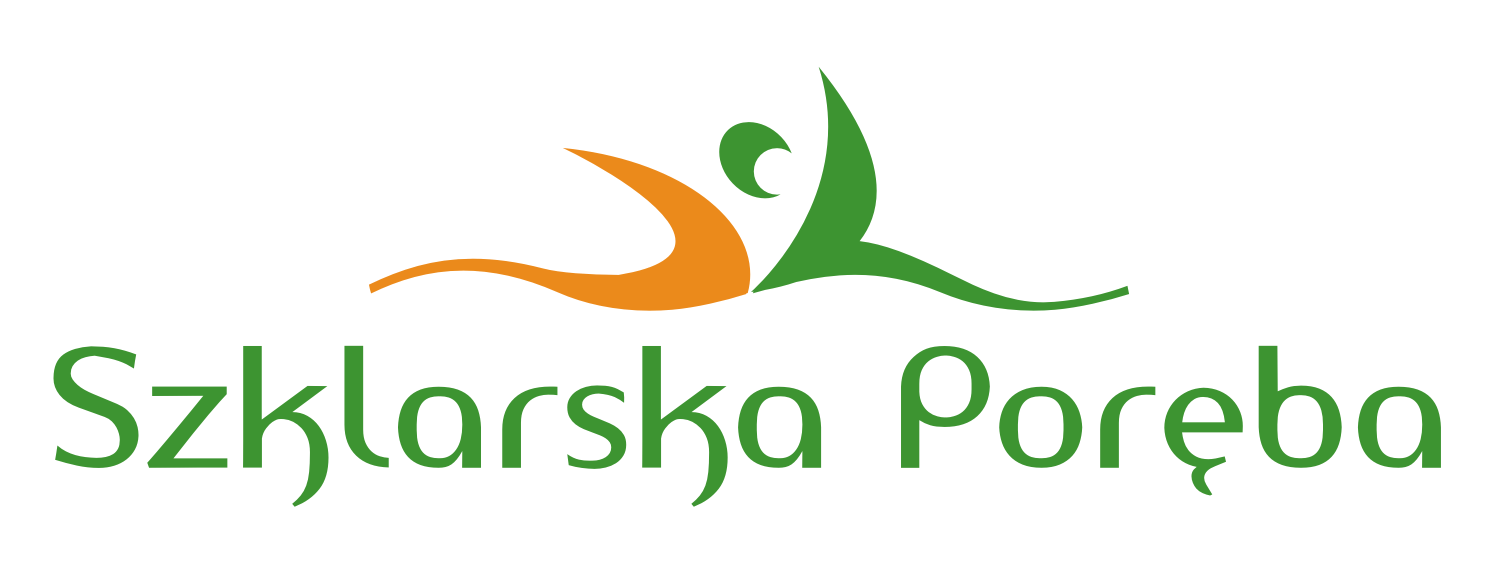 Logo miasta Szklarska Poręba w wersjach:
Logo miasta Szklarska Poręba w wersjach:
- logo wektorowe .cdr (Corel 8.0 lub wyższy)
- logo wektorowe .pdf
- logo rastrowe .gif
- logo rastrowe .png
- logo rastrowe .jpg
Wniosek o wydanie materiałów i wydawnictw promocyjno-informacyjnych
Druk w formacie Word (DOC)
Druk w formacie Acrobat (PDF)
Strategia Promocji
Strategia Promocji Miasta Szklarska Poręba na lata 2020-2027
- Details
Skład Rady Miejskiej kadencji 2018-2023 w Biuletynie Informacji Publicznej
Komisje - Kadencja 2018-2023 (w BIP)
Terminy posiedzeń komisji:
Komisja Rewizyjna – w każdy czwartek, godzina 1000
Komisja Finansów i Spraw Społecznych – w każdy piątek, godzina 1430,
Komisja Rozwoju Gospodarczego i Gospodarki Komunalnej – w każdy poniedziałek, godzina 1500,
Komisja Skarg, Wniosków i Petycji – termin posiedzeń ustalany na bieżąco.
Skład Rady Miejskiej ubiegłych kadencji oraz pozostałe informacje o RM (w BIP).












